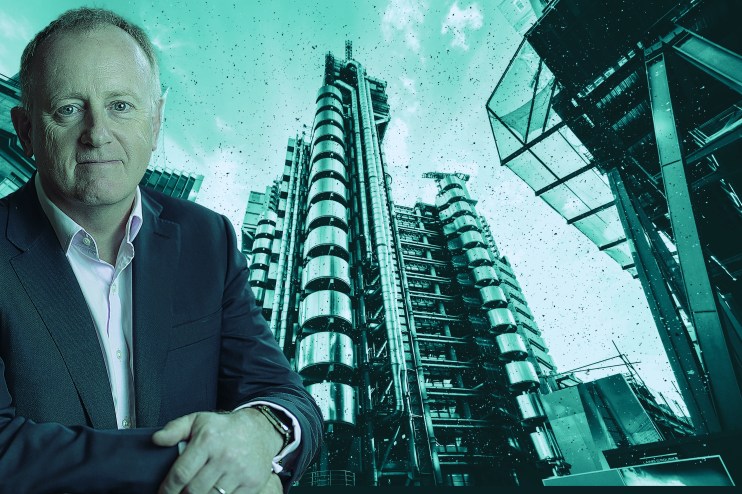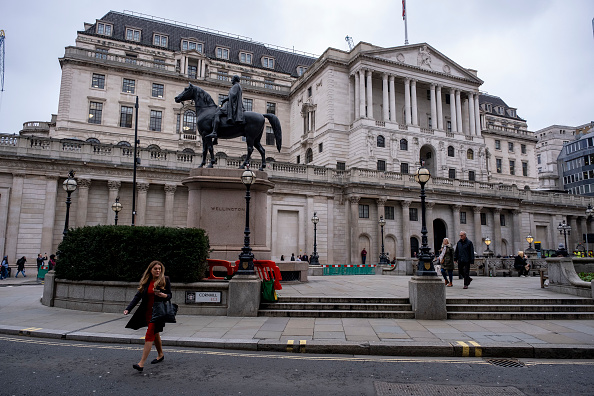John Neal: Why Lloyd’s of London ‘had to change’

Every week, Charlie Conchie sits down with the biggest movers and shakers in financial services. This week it’s John Neal, chief executive of Lloyd’s of London
It’s a Friday morning at Lloyd’s of London, and John Neal has just realised he has moth holes in his shirt. It’s not the first attack – he’s already written-off a favourite jumper at home with the same issue.
“Because it’s Friday, I’m just casual today,” he laughs from his office at the Square Mile’s historic insurance market.
While he’s joking, Neal’s choice of shirt might be telling. Back in 2018, months before he took over the reins as chief executive, Lloyd’s was only just relaxing a rule requiring the building’s army of underwriters and brokers to wear a tie to enter.
Since then he’s pushed Lloyd’s through a huge modernisation effort, spurred in part by an exposé of its boozy male-dominant culture but also by the more positive need to keep in step with the digital ways of the world.
Even as he’s championed a return to the building, he’s accepted the industry outside it has evolved. And if that means casual dress on a Friday, it seems, so be it.
“I think it had to change,” Neal tells City A.M. “The market has had to get more modern, more digital, more interactive, more professional in the way in which it measures risk, manages risk, solves risk.
“Tick, tick, tick,” he says, marking his work.
‘Lloyd’s is at the centre of the insurance market’
Despite the futuristic facade of the tower, with its organs attached on its external walls, little changed in its 340 year-old ways of working until the past decade.
Brokers and underwriters have gathered to manage the business of risk at Lloyd’s since its beginnings as Lloyd’s coffee house in 1686. Now, from ships, to oil rigs and footballer’s legs, if it’s insured, there’s a good chance Lloyds of London played a role in it.
The industry has been a pillar of London’s dominance as a financial centre, making up 24 per cent of the City of London’s GDP, according to the most recent 2020 data. London remains the only city in the world where every top-20 insurance and reinsurance firm has a base, according to the Global Cities Report of 2021.
Neal describes it as one of the three big bastions of the Square Mile, alongside the London Stock Exchange and the Bank of England. And while two members of that trio have been on an “interesting ride” of late after a battering from Brexit and covid, he says Lloyd’s is holding its own.
“I’d like to think that from the insurance angle of that trifecta, we put it back on the map,” he adds. “We’re growing, we’re profitable and I think it’s hugely important for UK PLC that Lloyd’s is at the centre of the insurance market.”
While it has undoubtedly fared better than its equity market sibling, the growth of London’s insurance industry too has somewhat stalled.
Caroline Wagstaff of the trade body, the London Market Group, last year described London’s share of the global market as “stagnant” at around eight per cent and weighed down by one size fits all regulation.
Neal can’t change the wider environment he’s been operating in for some 35 years, but he’s set about trying to reshape his own corner of it.
He started as an underwriter around the corner in 1985 working for a Lloyds motor syndicate, and aside from a seven year stretch in Sydney as chief of QBE Insurance, this section of the Square Mile has been home.
The type of insurance written by the market has transformed in that time. Areas like climate cover and cybersecurity risk have shot up the agenda and complicated what he described as an already “not vanilla” market.
Those emergent risks have also been a boon to its bottom line. In its most recent set of full year numbers, profits surged to £10.7bn, from an £800m loss a year prior.
face to face, is important, because the numbers on a piece of paper, tell a story, but they don’t tell the story
While the risks themselves may have changed, Neal says the physical space of Lloyd’s of London remains a fundamental part of the picture. He has just signed the firm on for another 11 years at its current base after fears had begun to spread that the firm was mulling an exit.
“I think the reality of physical interaction, face to face, is important, because the numbers on a piece of paper, tell a story, but they don’t tell the story,” he says. “The opportunity to truly represent why that risk is different to the way the piece of paper tells the story is the unique value of Lloyd’s.”
Much of its bumper growth in the past two years has also been down to the crystallised concept of risk that now grips the corporate world. Insurance premiums have been sent rocketing following a conveyor belt of crises in Brexit, covid and wars in Ukraine and Gaza.
For decades, returns have rumbled along at around the rate of GDP growth – now they’re running at nearly double.
That has made insurance an asset class that while riskier, is delivering a far better return to investors. They might not have planned for them, but bad things have largely been a good thing for Lloyd’s and the industry, Neal says.
“If you add all those things up for what we do for a living, it’s kind of good,” he adds.
“Everyone, right up to the C-suite within businesses recognizes that we’re in a risky world. We’re in a much riskier world than we were 5-10 years ago, and that’s our job.”

Culture change
That job, however, has been complicated somewhat in recent years. The market has been dogged by questions over its role in providing cover for fossil fuel projects, making the marketplace a favoured hangout for the likes of Just Stop Oil and Extinction Rebellion over the past year.
While Neal says “it’s not our job to set policy” and it would be “naive” to get into the ESG debate, it feeds into the more troubling narrative of the market as a bastion of the old City, one in which the traditional ways of doing things still dominate.
Part of that ire has been focused on its traditional culture of hard drinking. A culture so dominant that Neal says one of his “great strengths” in the 80s was that he was playing rugby so would avoid the drinking and get ahead while his colleagues were in the pub,
“I could be sat behind [my] underwriting box at 2:30 when other people would still be in the pub,” he says.
The dark side of that culture was brought blisteringly to the fore in 2019 by a Bloomberg investigation which exposed a culture of hard drinking and misogyny, in which several women alleged sexual harassment.
It spurred an overhaul in how Lloyd’s as a marketplace was run. Neal says he’s tried to “create the belief that the market wants to be inclusive” and “therefore the best talent will want to come to work with us.”
“Am I happy about [the behaviour]? No,” he adds. “We set ourselves targets around 35 per cent women in leadership: done. In terms of gender balance in the workforce, it is 50:50. We’ve set our hiring ambitions around colleagues from ethnic minorities.
“I think the fact these things are working should encourage us to just keep pushing, keep moving the dial, because it is ultimately a question of talent. We need the best talent.”
Neal has also set about stamping out the booziness, bringing in a policy to bar those under the influence of drink and drugs.
The internal bar has become a coffee shop, a hotline has been set up to expose bad behaviour, and anyone found responsible for sexual harassment risks being banned for life.
Fixing holes
Modernity and change are questions that have dominated the backdrop of Neal’s time in charge of the historic market. He has looked to push the business into the 21st century at a time when much of the City is facing questions over its future.
While he says Lloyd’s has been able to “work our way through that”, he has been a loud voice in sounding the alarm on the slide of the capital’s competitiveness, warning of the damage done by Brexit and political turmoil
“London was the gateway for America to Europe and the rest of the world, and I think it still is, but we’ve got a bit of work to do,” he adds.
“We’ve got work to do to repair those frameworks and evidence our credentials as one of the three main financial services markets in the world.”
Much like Neal’s jumpers, however, there may still be some holes to fix before all is looking right again.